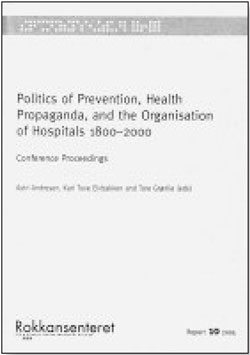Book review: Politics of prevention, health propaganda, and the organization of hospitals 1800–2000.
Michael 2006;3:76–7.
Andresen, Astri, Elvbakken, Kari Tove and Grønlie, Tore (eds): Politics of Prevention, Health Propaganda, and the Organisation of Hospitals 1800–2000. Conference Proceedings. RAPPORT 10–2005, Rokkansenteret, Stein Rokkan Centre for Social Studies, Bergen. 175 pp.

The Stein Rokkan Centre for Social Studies and the Department of History, University of Bergen, have hosted four Nordic-British workshops on the history of health and medicine, the most recent of these in February 2006. This book is a presentation of the proceedings of the third workshop, in March 2005. The articles are presented in three main sections according to the themes given in the title of the book and the workshop.
Proceedings from a conference or workshop will often be interesting to the reader, but these proceedings make me as a reader also wish I had been present on the occasion of the presentations! Although the three main themes seem to have been chosen more from availability than from logic, several of the articles are interesting descriptions and reflections on past events which, at least some of them, have not been well known to everyone interested in the history of health and medicine.
Anne Hardy’s article on food and hygiene in Britain 1945–2000 describes the rising number of food poisoning incidents in England and Wales, leading as recently as in 2000 to a symposium on hand hygiene, in order to focus attention on individual personal habits.
Jo Robertson tells the story of Culion, a small island in the Philippines that in 1904 was set up as a reservation to isolate people with leprosy in the Philippines. The initiative came from the American Army, due to concerns that American soldiers might otherwise contract leprosy. Legislation was adopted and a society constructed that in 1910 consisted of about 5000 inhabitants. The story of attempts to segregate young men and women and to remove newborn or young children from their parents is moving, as is reading about the author’s meetings with persons born on the island while it was still a colony for people with leprosy.
Elisabeth Hurren’s article on trafficking of bodies of the poor for medical research in England also gives food for thought. The Anatomy Act of 1832 and the New Poor Law of 1834 both further impoverished the poor and laid the foundation for this business of anatomy, that flourished from 1873 when an anti-welfare experiment («the crusade») was underway, and continued until 1914. We can read about anatomists at Cambridge University going on body-finding drives around the country, and about Oxford anatomists negotiating supply-deals with poor law guardians to outbid Cambridge in the purchasing of bodies of the poor. Hurren discusses these activities as a background to present-day debates in a biotechnical age.
Four articles focus on structure and organization of hospitals from historians’ viewpoint. We get to know part of the background of the creation of the National Health Service (NHS), even with a traditionally weak Ministry of Health. We read about the strong traditions of voluntary hospitals and charitable funding in England before the NHS. We share reflections on the attempts from the present-day Labour government to reconstruct the NHS as a regulated market, and proposals that in a worst-case scenario could open up for a creeping privatization of the service.
This book has points of interest both to historians, people in health administration and in the health services, and to those generally interested in present-day biotechnical debates as well.
MD, MPH
Institute of general practice and community medicine
University of Oslo
Po.box 1130 Blindern
N-0318 Oslo, Norway
